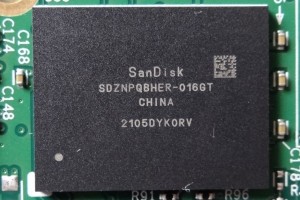REPORT ANALYSIS AND FINAL THOUGHTS
Corsair is the first that we know of to build on a great product, as seen in the Force GT which utilizes synchronous memory, and introduce a new SSD using Toggle Mode flash while stating that it will show its strengths in both high sequential and low 4k random write disk transfer. They are betting that Toggle Mode is a step up from synchronous memory.
 Interestingly enough, they elected to use SanDisk 24nm Toggle Mode NAND flash memory which we haven’t seen in any SSDs just yet.
Interestingly enough, they elected to use SanDisk 24nm Toggle Mode NAND flash memory which we haven’t seen in any SSDs just yet.
In fact, the only two other SSDs that I know of this memory being used are the Asian manufactured Silicon Power and Transcend SSDs. This made for an interesting benchmark evaluation.
With respect to performance, there were a number of hallmarks achieved by the Force GS and it started right off with very strong ATTO results and was followed by the incredible 4k random write result of 109MB/s. From there, we received one of the best AS SSD Copy Bench results we have seen to date and things only got better with an incredible high Total Score result in Anvil Storage Utilities. In short, each and every benchmark confirmed what we saw right from the start.
Value was our next concern, keeping in mind that the Corsair Force GS has just shown itself to be one of the top SSDs on the market, and also, we have gone through a great transition of dropping SSD prices in the past few months. We checked Amazon to find that the price of premium SSDs varies significantly from just above the $1/GB mark to above $500 still. It was definitely a surprise finding the Force GS selling at less than the buck a gigabyte mark and becoming one of the top values for such an SSD. At $217.29![]() for a new release premium 240GB SSD that just did what the Force GS did here, that is an incredible deal!
for a new release premium 240GB SSD that just did what the Force GS did here, that is an incredible deal!
In the end, we have performance, value, availability, a great capacity selection, decent 3 year warranty and the SSD does include a desktop bracket. The Corsair Force GS receives our Gold Seal and very strong recommendation for anyone looking to purchase an SSD.
 The SSD Review The Worlds Dedicated SSD Education and Review Resource |
The SSD Review The Worlds Dedicated SSD Education and Review Resource | 

Doesnt the Sandisk Extreme SSD 240GB use the same toggle NAND??
The identification numbers do not match that of the extreme. We have word that the answer is no but are hesitant to commit until SanDisk can confirm.
when will the days of drive makers OVERQUOTING the size of their drives, if I buy a 240GB drive, I want to use 240GB not a byte less!
Well, there is 2 answers to that question, its not only a ? about them deliberately putting incorrect values ??on, if i remember right its also the hole bits to byte or the other way around, but i got a IT education and a CCNA,but i cant remember the all the dif. values, other than a byte is “Normal” 8 bits, if u dont also count the “overhead”,then it can b 9 or even 10,hehe,anyways,the companys that sell u a HD define a megabyte = 1,000,000 bytes, but some OS/Programs/Systems(like Windows/Fdisk/Bios) say that a MB is = 1,048,576 bytes (if u dont belive me, go find a big file and right click on it, windows will say its like 6.5GB, but then in ( ) it will say its = 7.082.606.592 byte, so there u have why when they say the HD is 1TB, and u format it,and right click on it,it will never ever say u got 1 TB free! Hope u could use my answer, else try and google “what is a byte” or “Byte to bit converter” or what ever size u wanna get the “real” value of, like “TB to GB converter”!
Sincerely, Funk606
i have just put one of these drives into my dell xps 17 l702x and when i run crystaldisk im only getting about 45MB/s 4k write. should i be concerned? your help would be much appreciated
Conduct the test while your system is in safe mode and see the 4k result. It shoud be higher and this will let you know whether it is SSD/install related or he result of the OS environment. It is not Crucial that it be higher but we like to see it. Did u migrate or do a fresh install?
Thanks for quick reply. I did a fresh install of windows 7 and followed the optimization guide on here. My atto result is a tad off aswell. Only got 488MB/s write although the read hit 552. Just wondering if different systems with different hardware would affect the result
Have you followed my advise and tested in Safe Mode?
Yes I tested in safe mode with the same results. Not sure what it could be.
My sequential write on crystaldisk only hovers around the 200 mark too
I have Silicon Power V60 240GB for testing at the moment, it has the same Toggle Mode SanDisk Nand Flash modules found inside the Force GT, it is showing great performance up till the moment as well, with only 202 $ price tag @ Amazon. This is a real deal 🙂